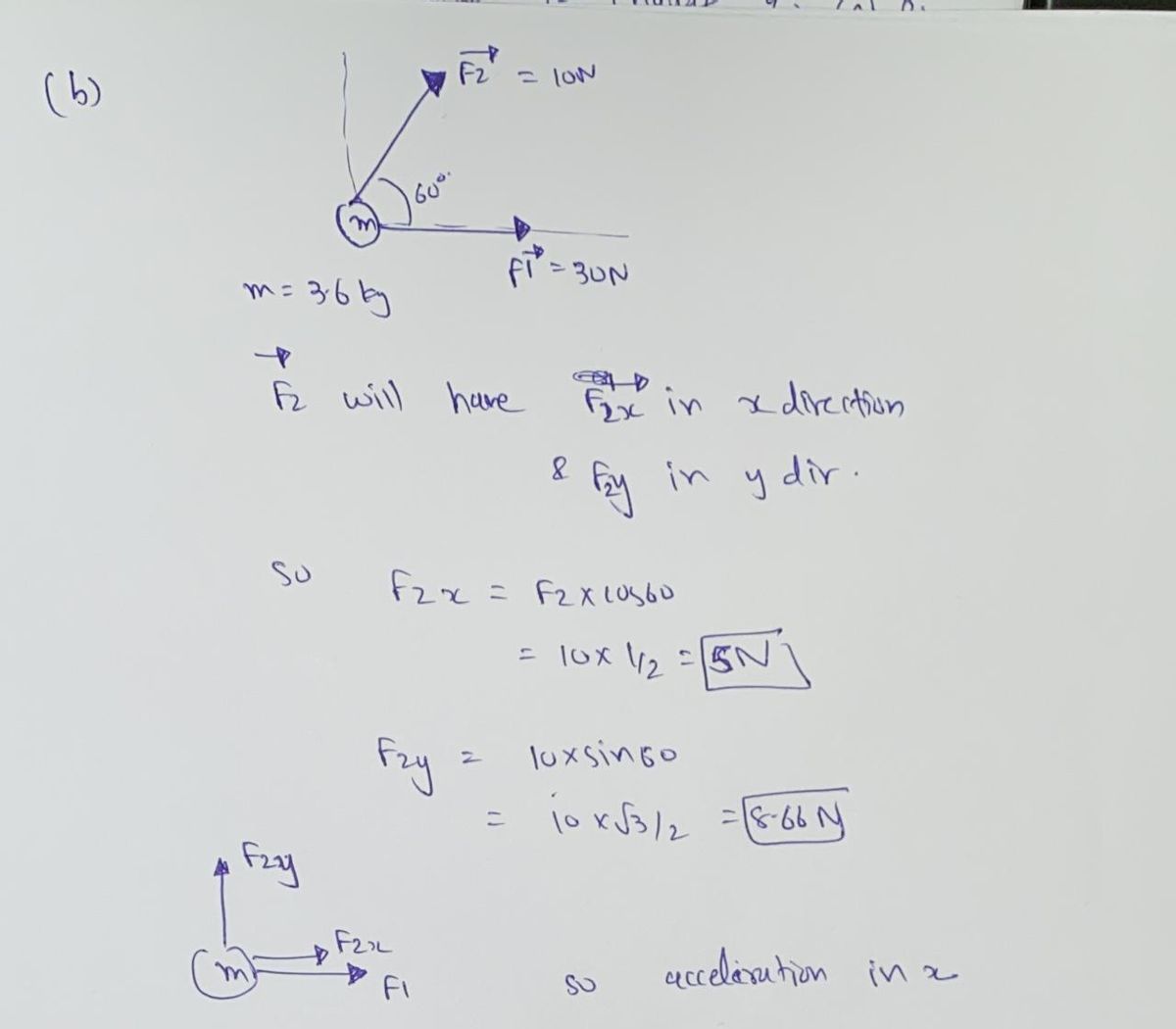Two forces F,1 and F, act on a 3.60-kg object. F, = 30.0 N and F, = 10.0 N. 90.0° 60.0° m (a) Find the acceleration of the object for the configuration of forces shown in Figure (a). magnitude 8.78 m/s? direction 18.4 ° (counterclockwise from F,) (b) Find th ation of the object for the configuration of forces shown Figure (b). 10.9 magnitude You find the magnitude of a force in the same manner you find the magnitude of any other vector: first resolve each vector into components. m/s? 23.4 direction You can determine the angle from the components of the net force, or from the components of the acceleration.° (counterclockwise from F1)
Two forces F,1 and F, act on a 3.60-kg object. F, = 30.0 N and F, = 10.0 N. 90.0° 60.0° m (a) Find the acceleration of the object for the configuration of forces shown in Figure (a). magnitude 8.78 m/s? direction 18.4 ° (counterclockwise from F,) (b) Find th ation of the object for the configuration of forces shown Figure (b). 10.9 magnitude You find the magnitude of a force in the same manner you find the magnitude of any other vector: first resolve each vector into components. m/s? 23.4 direction You can determine the angle from the components of the net force, or from the components of the acceleration.° (counterclockwise from F1)
College Physics
11th Edition
ISBN:9781305952300
Author:Raymond A. Serway, Chris Vuille
Publisher:Raymond A. Serway, Chris Vuille
Chapter1: Units, Trigonometry. And Vectors
Section: Chapter Questions
Problem 1CQ: Estimate the order of magnitude of the length, in meters, of each of the following; (a) a mouse, (b)...
Related questions
Question
cant seem to get the bottom figured out, i keep getting differnt answers

Transcribed Image Text:Two forces F, and F, act on a 3.60-kg object. F, = 30.0 N and F, = 10.0 N.
1
90.0°
60.0°
m
(a) Find the acceleration of the object for the configuration of forces shown in Figure (a).
magnitude 8.78
m/s?
direction
18.4
° (counterclockwise from F,)
(b) Find the acceleration of the object for the configuration of forces shown in Figure (b).
10.9
magnitude You find the magnitude of a force in the same manner you find the magnitude of any other vector: first resolve
each vector into components. m/s-
23.4
You can determine the angle from the components of the net force, or from the components of the acceleration.
(counterclockwise from F1)
direction
Expert Solution
Force Componants

Trending now
This is a popular solution!
Step by step
Solved in 2 steps with 2 images

Knowledge Booster
Learn more about
Need a deep-dive on the concept behind this application? Look no further. Learn more about this topic, physics and related others by exploring similar questions and additional content below.Recommended textbooks for you

College Physics
Physics
ISBN:
9781305952300
Author:
Raymond A. Serway, Chris Vuille
Publisher:
Cengage Learning

University Physics (14th Edition)
Physics
ISBN:
9780133969290
Author:
Hugh D. Young, Roger A. Freedman
Publisher:
PEARSON

Introduction To Quantum Mechanics
Physics
ISBN:
9781107189638
Author:
Griffiths, David J., Schroeter, Darrell F.
Publisher:
Cambridge University Press

College Physics
Physics
ISBN:
9781305952300
Author:
Raymond A. Serway, Chris Vuille
Publisher:
Cengage Learning

University Physics (14th Edition)
Physics
ISBN:
9780133969290
Author:
Hugh D. Young, Roger A. Freedman
Publisher:
PEARSON

Introduction To Quantum Mechanics
Physics
ISBN:
9781107189638
Author:
Griffiths, David J., Schroeter, Darrell F.
Publisher:
Cambridge University Press

Physics for Scientists and Engineers
Physics
ISBN:
9781337553278
Author:
Raymond A. Serway, John W. Jewett
Publisher:
Cengage Learning

Lecture- Tutorials for Introductory Astronomy
Physics
ISBN:
9780321820464
Author:
Edward E. Prather, Tim P. Slater, Jeff P. Adams, Gina Brissenden
Publisher:
Addison-Wesley

College Physics: A Strategic Approach (4th Editio…
Physics
ISBN:
9780134609034
Author:
Randall D. Knight (Professor Emeritus), Brian Jones, Stuart Field
Publisher:
PEARSON